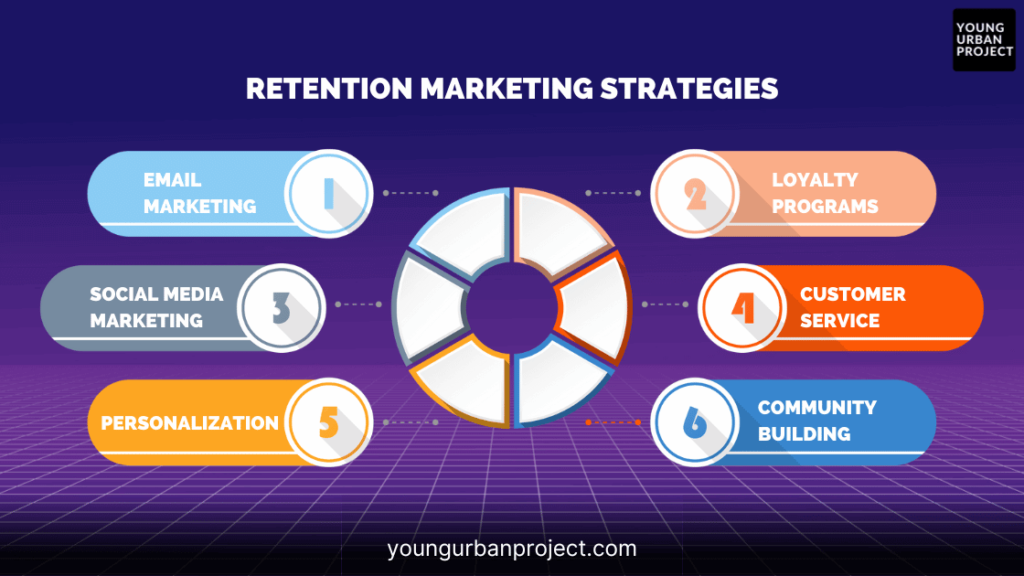Retention marketing is a specific type of marketing where the focus is on keeping customers engaged and satisfied with a company’s products or services in order to prevent them from leaving.
It is a key strategy for any brand looking to grow and sustain its customer base.
One way to look at retention marketing is that it is the opposite of acquisition marketing or performance marketing, which focuses on acquiring new customers.
Instead of only trying to sell to new customers, retention marketing aims to turn existing customers into repeat purchasers.
While both are important, retention marketing can often be more cost-effective and lead to higher lifetime value (LTV) for a brand.
Table of Contents
Retention Marketing Strategies

1. Email Marketing
One way how brands can leverage retention marketing is by the use of Email Marketing. Sending targeted Emails is a powerful tool for nurturing relationships with customers and keeping them engaged with a brand. By sending targeted, personalized emails to existing customers, brands can offer valuable content, promotional offers, and other incentives that encourage customers to return back to do business with them.
2. Loyalty Programs
Another way brands can make use of retention marketing is by introducing loyalty programs for their existing customers. These programs offer rewards and incentives for customers who make repeat purchases or engage with a brand in other ways. By offering rewards for making repeat purchases, brands can encourage their customers to stay loyal to the brand and continue doing business with them.
Airline brands like Vistara have their ‘frequent-flyer’ loyalty programs where customers earn rewards (or flying miles) when they book flights. And customers can use these rewards to get discounts on future flights or get seat upgrades.
3. Social Media Marketing
Apart from email and loyalty programs, brands can also leverage retention marketing through the use of social media platforms. Brands can engage with their customers on social media, can build non-transactional relationships, and share valuable content that keeps the customers interested in their brand and increase recall.
You might have seen brands like Zomato and Netflix use social media in a smart way to keep their customers engaged and to share promotional offers (coupon codes) for incremental sales.
Brands can also use social media to run contests and giveaways, which is a great way to keep customers hooked.
4. Customer Service
Another key component of retention marketing is customer service. By providing great customer service, brands can make sure that customers are satisfied (and delighted) with their products & services, and are more likely to continue making repeat purchases. Brands can also use customer service as an opportunity to gather feedback and make improvements to their products or services, which can further help increase customer satisfaction and retention.
5. Personalization
Brands can also use retention marketing through personalization. By making use of data & analytics to understand individual customer behavior, brands can tailor their marketing efforts and offer personalized experiences that keep customers coming back. Brands can also create cohorts of users, that behave in a similar way, and personalize messaging for them
Personalization can include elements like tailored product recommendations, customized emails, and more.
6. Building a Community
And lastly, brands can use the power of retention marketing through ‘community building’. By creating an online community around their brand, brands can nurture a deep sense of belonging among their customers.
A community serves as a space where your customers can interact with other like-minded individuals who have similar interests.
An online community can be built using a support forum, a Facebook group, or even a Discord server. Some brands might want to create a self-hosted community for their customers.
This engagement can not just be between customers and the brand, but also among customers themselves.
In this age, building a community around a brand is immensely powerful. It can reduce overall acquisition and retention costs.
This can lead to increased loyalty, word-of-mouth marketing, and repeat business.
Retention Marketing Case Studies
Let’s look at how some popular brands make use of retention marketing to nurture customer relationships and increase the LTV.
Starbucks:
Starbucks is a great example of a brand that has used retention marketing with a lot of success. The coffee giant has a loyalty program (a Starbucks card) that rewards customers with free drinks and food for repeat business. Customers can load their accounts in advance with funds and can keep buying from Starbucks using their accounts.
A recent report said that Starbucks customers had collectively stored $1.5 billion in their accounts. That is all interest-free money that Starbucks gets to have – in advance. This is possible due to the massively successful loyalty program that Starbucks has created.
Additionally, Starbucks uses email marketing to send personalized offers and promotions to customers, which encourages them to continue doing business with the brand.
Amazon Prime:
E-Commerce giant Amazon is another brand that has used retention marketing to get a lot of success. The company uses personalized product recommendations, targeted email marketing, and Prime membership (which is a loyalty program) to keep customers engaged and returning back for repeat purchases. Amazon’s retention strategy has been super effective.
It was reported that Amazon Prime members spend an average of $1,400 annually on the platform, versus only $600 per year for non-Prime members.
This is a clear incremental benefit of the loyalty program. It also justifies the reason why Amazon is okay with pricing the Prime membership at a really low cost.
Netflix:
Netflix is King when it comes to using data for personalization, or for shipping product features. Netflix uses retention marketing to keep customers engaged with its content. The streaming giant uses data and analytics to understand individual customer preferences and then uses that information to recommend content that is tailored to each customer.
Each viewer not only sees personalized recommendations for movies and TV Shows but even the thumbnails of the content are personalized based on each viewer’s content preference & consumption pattern.
This personalized experience keeps customers engaged and coming back for more.
Zappos:
Zappos is an iconic brand that is known for selling shoes, clothing, and accessories. The brand has a retention marketing strategy that hugely focuses on customer service (they even highlight this on their website).
The company has a very flexible 365-day return policy and free shipping, which gives customers the freedom to try on their shoes and make sure they’re satisfied with their purchase. This also shows the confidence Zappos has in its own products.
This policy has helped Zappos nurture and retain customers, and the company is known for having an extremely loyal customer base.
Peloton:
Peloton is a fitness equipment and content company that is one of the recent success stories when it comes to retention marketing.
The company uses a personalized approach to fitness, through its interactive video classes and personalized training.
The platform uses data and analytics to understand individual customer fitness preferences and goals, and then recommends the ideal workout plan. This helps them to retain their customers and enhance customer satisfaction.
Conclusion
In the end, retention marketing is an important strategy for any brand that wants to grow and sustain its customer base without only relying on new acquisitions for generating revenue.
This is something brands need to focus on from an early stage.
Many brands wait to introduce retention marketing after they have grown to a certain stage, but it is recommended that brands focus on it from day 1.
By making use of retention strategies like email marketing, loyalty programs, social media, customer service, personalization, and community building, brands can keep customers engaged, delighted, and satisfied with their products or services, which can lead to incremental loyalty and repeat purchases.
If you would like to see more marketing content like this daily, click here to Follow us on Instagram.

